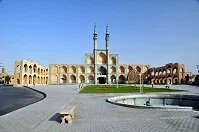Beyond the Great Mosque, the rest of Esfahan is nearly as impressive and much of the city's historic heart was built during this time. It is here that some of the oldest minarets in Iran are still standing. Many of the buildings from the Seljuk period were covered with stucco or made of brick. Another important decorational aspect from this time is tile mosaics.
In about the 1300s the Il-Khanid architectural period developed and again was a style that built off of earlier structures, not creating something entirely new or unique. Despite this, the structures are still very impressive and the period's highlight is probably the Mausoleum of Oljeitu in Soltaniyeh or the Ali Shah Mosque in Tabriz. These buildings' major purpose was to define and symbolize power so are huge structures.
By the end of the century though the Timurids had arrived from Central Asia and, although they left behind few buildings in modern day Iran, the city of Tabriz has a few buildings from this time. Most of the Timurid buildings remain in Central Asia (primarily Uzbekistan), however most of them and those in other countries are heavily tiled structures in blue.

Mosque in Yazd
In the 1500s the Safavid Dynasty (lasting until the 1700s) solidified power in the region and built their capital in the city of Esfahan, adding to the already great architectural history of the city. The city was built by the new rulers as hundreds of mosques and thousands of other buildings were erected. Although few buildings from this time period remain standing, the buildings surrounding Meydan-e-Shah, a large park or open square, were built during this time and this remains the heart of the city today. Only the Palace of the Forty Columns (Chehel Sotun) is original from this time. More than the buildings and facades, the square created a central theme to later Islamic architecture as it combined an open public space with religious, educational, and commercial buildings, creating a meeting place for the people of any city.
Since the 1700s few buildings on the scale of, or the ingenuity of, the Safavid Dynasty have been constructed. Numerous impressive buildings have been built during this time, but few were extraordinarily original. The National Museum of Iran, built in the 1920s is impressive as it was modeled after historic architecture, while the Tehran University is more a combination of historic style with modern building techniques.
In more recent times, Iran has received modern buildings, which are much easier to build due to the materials and machines created by the Industrial Revolution, including concrete, steel, and cranes. There are numerous modern buildings in the country, most particularly in the capital city of Tehran.